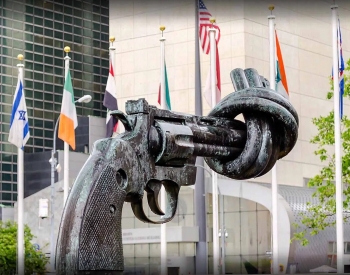Final statements in thematic discussions emphasized the important role of the First Committee. They are a group capable of promoting multilateralism and implementing global disarmament—it is crucial that they accomplish such. The actions delivered through this conference can have great impacts on our fragile state of global insecurity.
Throughout the week, state representatives cast votes on 128 separate occasions, which led to decisions for 75 draft proposals. Out of those proposals, 74 were approved and passed along for adoption, while 1 was withdrawn. These approvals reflect efforts to improve conditions and regulations surrounding nuclear weapons, weapons of mass destruction (WMD), conventional weapons, outer space security, cyber security, and other general disarmament measures.
Key resolutions in the field of nuclear weapons included L.17, which called on states to sign, ratify, accept, approve, or accede to the Treaty on the Prohibition of Nuclear Weapons. This resolution was approved with a 124 - 43 vote. Furthermore, resolution L.42 called upon states to sign a no-first-use of nuclear weapons agreement, which would be legally bound. This resolution also declared that states cease the development and improvement of nuclear warheads, as well as the deactivation and reduction of nuclear weapons. L.42 passed with a 118 - 42 vote. In regard to the humanitarian effects of nuclear weapons, resolution L.16 was approved with a 141 - 12 vote, calling for states to prevent the use of nuclear weapons, work towards disarmament, and eliminate the threat of WMD.
Conventional weapons, which are responsible for the largest percentage of civilian deaths and injuries, were also addressed in multiple proposals. Resolution L.41 addressed explosive weapons in populated areas (EWIPA), directing states to counter these weapons, combat terrorist groups posing threats to civilians, and reduce the harm imposed upon civilians. The use of anti-personnel mines was also condemned in L.40, as states were urged to accede to the Anti-Personnel Mine Ban Convention. Resolution L.50 addressed the illegal arms trade and L.39 pushed a commitment to the Arms Trade Treaty, and both implemented measures to fight against the widespread violence imposed by illegal firearms.
Numerous other resolutions were proposed and approved, while many nations offered explanations as to why they cast their vote in a particular way. With this influx of new resolutions, future actions, agreements, and disarmament are anticipated to follow.
To read more, please visit:
- https://reachingcriticalwill.org/disarmament-fora/unga/2022/statements
- https://press.un.org/en/content/first-committee
by Nicole Piusienski







